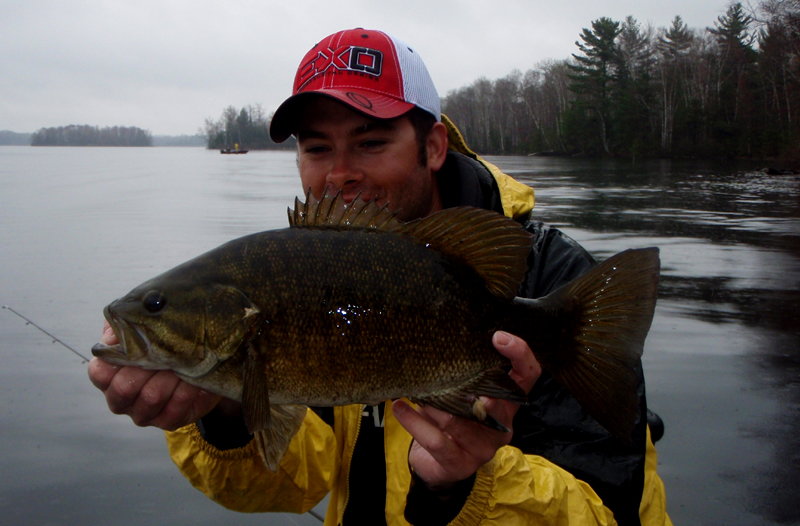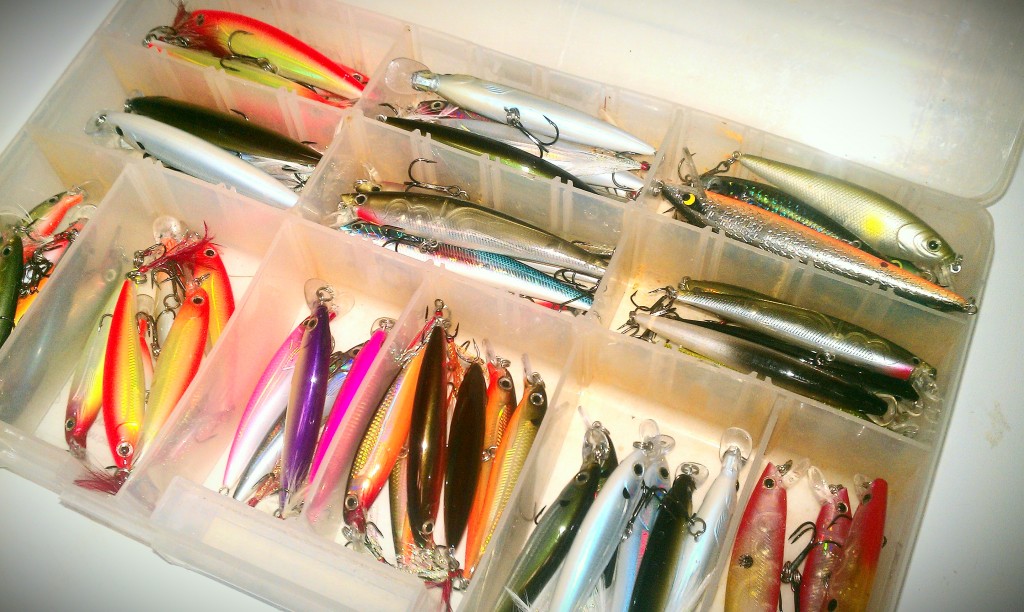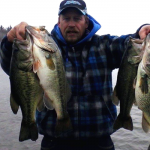By Andrew Ragas
It’s the weekend of Wisconsin’s gamefish season opener. As I tortuously wait for up to 24 inches of ice and slush to melt, I have nothing better to do than fantasize over the plethora of 5 pounders I am set to catch thereafter. Fishing in the north country is shifting from ice shanty to boat. As ice melts away, anglers like myself will hit the water for a festival of trophy smallmouth bass.
In my opinion, the first three weeks following ice-out, preceding to the spawning period offers anglers some of the best fishing of the year. About a week following ice out, smallmouths are usually schooled and stacked in large groups along the edges of structural elements. In contrast to largemouths which will move into shallow mud bays with warmer water, smallmouths move to warm water lake locations that are best influenced by wind direction, sunlight penetration, and proximity to annual spawning location.
Identify these spots, you can literally catch 100 fish or more in a single day.
ARTICLE: Spring Meteorology and Smallmouth Bass

In regions where early season bass fishing is allowed following ice out, many anglers find themselves at a standstill on where to fish and the techniques to fish with. At seminars and even on the water, the most popular questions asked about spring fishing always relate to presentation: “What are your best baits to fish with? And why do you fish with them?” Over the years, I’ve found that certain strategies work better than others when the ice disappears and bass reappear, lasting through the spawning period.
One of the fascinating aspects of bass fishing is that patterns, techniques, and colors work universally, almost everywhere smallmouths populate. However, the specific techniques and lure types I fish most often in spring seem to relate best by region and specific water bodies. With 99% of my trophy smallmouth fisheries being located in the Upper Midwest and Great Lakes region, nearly all of my spring techniques have been honed, modified, and mastered to my specifications and angling style and work on each of them.

Deep Water
In recent years, I’ve developed an affection for locating open water schools of smallmouth. Fish are always found with electronics in off shore locations, usually within short distances from their spring staging spots. During my first outings of the year, I like to begin deep, looking for fish in the 15 to 30 foot zones. By working closely with my Lowrance Elite-7 HDI that’s equipped with Lake Insight HD charts and down imaging, I make quick drive-by’s along the deepest edges of spring feeding flats, and the sides of rock humps. In these open water locations, seeing the markings of schooling smallmouth will be obvious on-screen.
A key forage for my bodies of water in early spring are smelt, mud minnows and yellow perch. For that reason, I often focus on long, slender 3 to 5 inch baits.

Jig and Minnow Style Plastics – I use soft jerkbaits rigged on a minnow style jig head a lot in mid-summer and fall when smallmouths are deep. However, they also have a time and place in the spring, and that takes place from ice-out until fish move in too shallow, thus eventually making this technique ineffective. Soft jerkbaits in the “fluke” style such as a Trigger-X Minnow, GNUGEN Lures Live Minnow, and Stankx Bait Company Fluke are pitched and vertically jigged in horizontal presentations. I prefer using Northland Mimic Minnow, and Matzuo Minnow Head jigs in 1/8 or 1/4 oz sizes depending upon depth and wind.
My approach is methodical for these deeper schooling smallmouth. I don’t fish from the front deck. I also don’t cast blindly. I only fish vertically with jig and minnow combos when smallmouths are pinponted on my Lowrance on the console. From the back end of the boat, I can control my bow mounted Minn Kota Powerdrive by remote. I also leave it deployed in the water at all times, because when smallmouths will be on the move, I can trail them by idling with the big motor. When located again, I’ll shut off the outboard and resume my remote control game; a system making boat control a thing of beauty.
TACKLE – 7 foot medium and medium-heavy action Quantum Tour Edition rods with Energy 20 and 30 PTi spinning reels spooled with 15 lb Cortland Masterbraid with a 2 foot, 12 lb fluorocarbon leader.
Staging, Mid-Depth
So, the fish are hungry and vicious. As the water warms a little, the fish will move toward the shallows, and stage for the spawn. Along with these schools of staging fish, my boat likewise progresses shallower also, to the 5 to 15 depth range along the edges of shallow spawning flats.

Carolina Rigged Minnow – Throughout the Great Lakes smallmouth fisheries, bass anglers have applied carolina rigging concepts with soft plastic minnows to catch fish from these alewive and smelt-rich waters. In mid-depth staging areas of Northern Wisconsin lakes, I like to drift fish and use wind to my advantage using these same concepts.
Soft, flexible minnows such as a Trigger-X Minnow and GNUGEN Lures Live Minnow are casted in horizontal presentations, always retrieved with bottom contact in mind. Rigged between a 3/8 oz egg sinker, ball bearing swivel, Lazer Trokar 2/0 HD Worm Hook and 24 inches of 12 lb fluorocarbon leader, the Carolina Rigged minnowbait is an underfished, little-known player in my northern bass world.
TACKLE – 7 ft 4 in medium heavy Quantum Superlite spinning rods with Quantum Energy 30PTi spinning reels. Spooled with 8 lb Cortland Camouflage Extra-Soft.
Swimming Grub – I learned to catch my first smallmouth bass with the swimming grub and this is a tactic I still heavily rely on early season success for not only action, but big fish. Tie on a 4 inch Kalin’s grub, and rig it with either a Northland Mimic Minnow, or Matzuo Minnow Head jig in 1/8 or 1/4 oz size. Instead of allowing the grub to work its way down into the rocks, it’s best fished to cover large expanses of water with a predominant slow swimming retrieve and occasional bottom grazing.
Swimming the grub is a deadly finessed-down search bait, as well as a bait for enticing bites once fish are located. As you move along the shoreline, or cover the entire sand bar or rock flat, it is possible to cover the same amount of water that you would if you were fishing a spinnerbait. But instead, you are using a more subtle presentation.
TACKLE – 7 foot medium and medium-heavy action Quantum Tour Edition rods with Energy 20 and 30 PTi spinning reels spooled with 15 lb Cortland Masterbraid with a 2 foot, 12 lb fluorocarbon leader.
- Kalin’s Grub
- Kalin’s Grub
- Carolina Rigged Minnow
Shallow Pre-Spawn
After the water finally warms to 55 degrees, smallmouths bolt for the shallows and congregate near their yearly spawning locations. This is when I demoralize fish with a suspending jerkbait. I believe a suspending jerkbait outfishes everything else during the short window preceding the spawn. Because water temperatures are still on the cold side, I am slow with my approach and focus on a plotted milk-run of known spawning flats.
Suspending jerkbaits catch early spring smallmouths better than most other baits I throw. Part of it is through technique while most of it is due to their capability to freeze in space and hover in the faces of fish. Since jerkbaits seem to outfish other artificial minnowbaits by a wide margin in spring, I can only speculate that suspense and rattles are at the forefront of its success.

Rapala X-Rap – My favorite jerkbait and smallmouth lure of all time is the Rapala X-Rap in sizes 08 and 10. I’ve written extensively about them but never in an early spring themed article. They work in most situations, allow for long casts and maximum water coverage, trigger active and inactive fish, and suspend the best of any bait in its class. Smallmouths respond to the pause about 99% of the time. They suspend perfectly, and work best when worked progressively faster as the water warms and when retrieve is catered to the activity level and feeding moods of fish. Color choice is purely optional as I’ve caught smallmouth on almost every color in its lineup. But if I were to select, my best producers are hot head (yellow and orange), moss chartreuse shad, albino shiner, purple gold, and rusty crawdad.
The best retrieve is one where the angler can be creative and form an aggressive retrieve that is based according to the behavior of the fish.
TACKLE – (X-rap 08) 7 ft medium heavy Quantum Tour Edition spinning rods with Quantum Catalyst 30PTi spinning reel. Spooled with 8 lb Cortland Endurance monofilament. (X-Rap 10) 6 ft 10 in medium heavy Quantum Energy casting rod with Energy PTi 6.3:1 gear ratio. Spooled with 10 lb Cortland Endurance monofilament.
Matzuo Phantom Minnow – Following ice-out in spring 2013, the 4 inch Phantom Minnow put more big smallmouth bass in my boat than any other lure. The Matzuo Phantom Minnow’s erratic darting action and holographic color patterns appeal well to coldfront and staging smallmouth bass. Known to draw slashing strikes, enticed by its rattle chamber and suspending profile, the Phantom Minnow is an exceptionally versatile lure that can be used for pulling up fish suspended in deep water or shallow water. When staging prespawn fish are located in massive numbers, any suspending jerkbait with a rattle chamber has the potential of enticing strikes as good as the Phantom Minnow.
TACKLE – 7 ft 4 in medium heavy Quantum Superlite spinning rods with Quantum Energy 30PTi spinning reels. Spooled with 8 lb Cortland Camouflage Extra-Soft.

Tube Jigs – Fishing bottom oriented baits for smallmouth bass is an often overlooked spring tactic. Anglers usually turn to the fast, reactionary strike approach of jerkbaits before rapidly slowing down the pace to meticulously fish with plastics such as the tube. Often times, during the cold misery of spring, anglers fail to slow themselves to the pace of cold water smallmouths. Luckily the tube jig is a perfect choice for this, especially when fish are beginning to transition, and water temperatures are above 55 degrees.Tubes make so much sense because as smallmouths are transitioning from the wintering depths to the shallow water of the flat, crayfish also follow suit. Anything resembling crayfish is a guaranteed meal for smallmouth bass, and tubes are the ideal representation.
What I look for in a quality smallmouth tube is its plastic formula, its level of salt and additive impregnation, availability of colors and attention to detail, and durability. A few brands meet all these requirements for my preferred tubes, and they are made by Strike King (Coffee Tubes), YUM, and Stankx Bait Company (DD Tubez). In my opinion, color seems to have less of an impact or significance than the size, profile, and scent of the tube.
TACKLE – 7ft medium heavy Quantum Tour Edition spinning rods with Quantum Smoke 30PTi spinning reels. Spooled with 20 lb Cortland Masterbraid with a 3 foot, 12 lb fluorocarbon leader.
- StankX DD Tube
- StankX DD Tube
- Rapala X-Rap
Ice out is a feast or famine time of year for smallmouth bass. My advice and presentation picks are simple however, and all are central to the early spring minnow and baitfish feeding movements exhibited by smallmouths.
If you fail to contact fish early, move. It’s on to the next area that offers feeding and structure opportunities. In spring, they are not going to be located everywhere and in several spots like later on in the season. Look for places where fish want to be connected to structure, and puzzle these pieces together from the depths to shallows. Run these high percentage areas I’ve described and you’re eventually bound to find fish foraging in an area.














